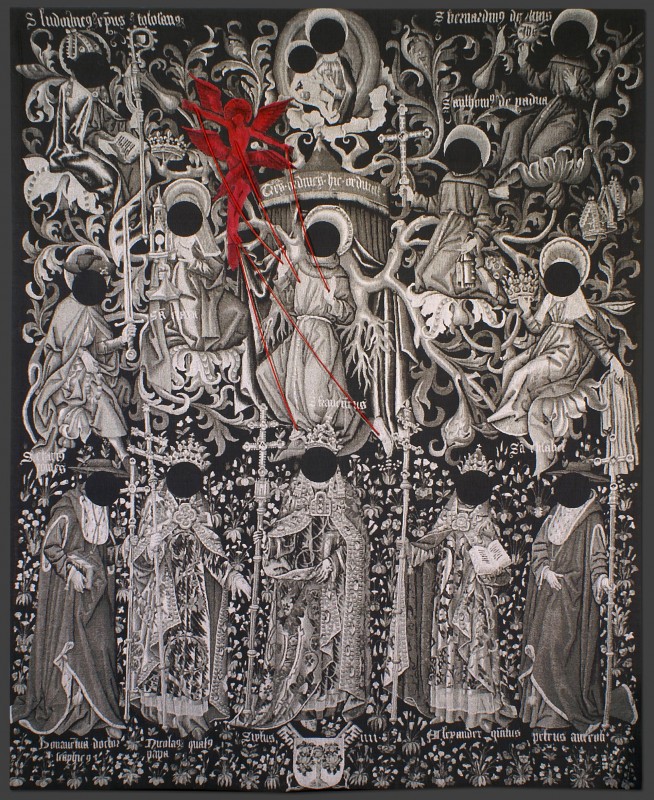
Jacquard tapestry, hand-painted by artist with cording
100 x 76 in.
edition of 5
Darren Waterston produced two new editions with the Magnolia Tapestry Project in 2006, entitled Tree of Saint Francis and Tree of Saint Francis II. Both editions possess the intense, slightly sinister beauty and the tension between abstraction and figuration that are hallmarks of Waterston’s work. These tapestries reference the history and physical properties inherent to the woven medium without sacrificing Waterston’s startlingly original and distinctly contemporary aesthetic.
Waterston’s point of departure is The Franciscan Tree, a 15th century Flemish tapestry depicting a mythical family tree centered around Saint Francis of Assisi. Francis was a wealthy 12th century dandy who eventually embraced poverty and charity and founded the Franciscan order. The most dramatic and well-known episode in Francis’s legend is his vision of a seraph — a crucified angel with six wings — and subsequent receipt of the stigmata: an open wound at his side and nails of flesh through his hands and feet. The tapestry imagines a direct lineage involving the Virgin and Child, a Pope, and various saints and contemporaries of Francis. These figures are arranged as part of a richly detailed tree, surrounded by a complex network of tendrils, roots, leaves and flowers.
In Tree of Saint Francis, Waterston re-imagines The Franciscan Tree in a crisp, dramatic grisaille palette. The heads of its medieval cast have been replaced with large black circles. Waterston applied red fabric paint by hand to the flying Christ-seraph, and the lines of stigmata running from the seraph to Saint Francis have been realized as red cords at the surface of the tapestry. In Tree of Saint Francis II, Waterston marries his grisaille, anonymized Franciscan Tree with an earlier tapestry design, Feeders, merging the medieval figures of the former with the haunting, organic abstractions of the latter.
It is easy to see how The Franciscan Tree, with its otherworldly growth of esoteric figures from vine-like branches, would appeal to the sensibilities of an artist for whom plant growth and surreal, floating figures have been favorite visual devices. Waterston is best known for his virtuosic paintings in which layers of oil, beeswax and encaustic evoke a host of phenomena: meticulously rendered flora, fauna, and natural processes of growth, generation, and decay coexist with mysterious marks which seem to record some fantastic, even metaphysical activity. “Waterston has a great sense of mutational improvisation,” writes Benjamin Weissman in a 2001 essay, “The space [he] creates…is a gravity-free zone where all elements are in suspended animation.” By applying his “mutational improvisation” to a medieval masterpiece, Waterston has created two visually sumptuous editions which possess a studied historical resonance.
– Nick Stone
show prices
Prices and availability are subject to change without notice.The copyright of all art images belongs to the individual artists and Magnolia Editions, Inc.
©2003-2024 Magnolia Editions, Inc. All rights reserved. contact us
